Texas Railroad History - Tower 40 - Luling
A Crossing of the Galveston, Harrisburg & San Antonio
Railroad and the San Antonio & Aransas Pass Railway
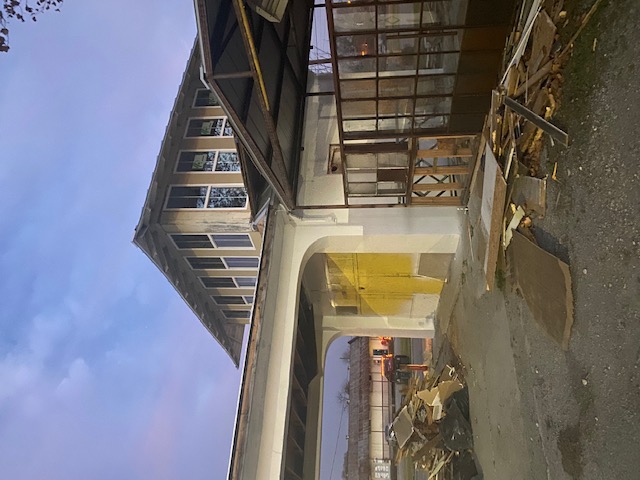
Above: After being
repurposed at various times over many decades, Tower 40 and an adjacent
building (added after the tower's retirement) have been
remodeled into a new bar and food truck court
named "The Station" in honor of its prior uses as a railroad
facility and a gas station. The view from the tower should make it a great
place to watch trains! (Stacy Metzler photo, January 20, 2023) |
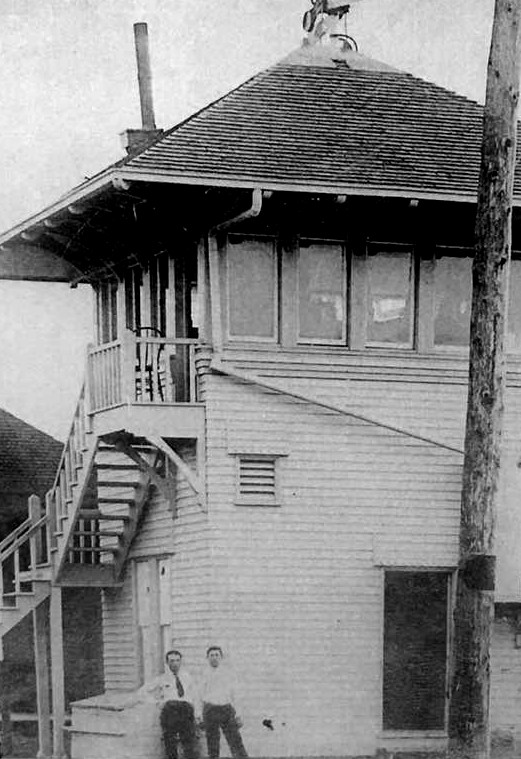
Above: Tower
40 (undated, Luling Oil Museum, hat
tip Ronnie Lewis) |
The Buffalo Bayou, Brazos and Colorado (BBB&C)
Railway, the first railroad in Texas, was chartered a few years before the
Civil War. It began construction at
Harrisburg on Buffalo Bayou southeast
of Houston and laid twenty miles of track west to
Stafford's Point in 1853. By the end of 1855, twelve additional miles had been built to Richmond
on the west bank of the Brazos River, the county seat of Fort Bend County. The next five years
saw tracks laid 48 miles farther west to the tiny community of Alleyton, three
miles east of the Colorado River, a river the BBB&C did not plan to cross.
Instead, the charter called for the railroad to remain east of the
Colorado and follow the river north to La Grange and Austin, but the Civil War
curtailed those plans. Post-war economic conditions
left
the BBB&C unable to make payments on its construction contract, and as a result,
an 1867 court
judgment awarded the BBB&C to the contractor, William Sledge.
Sledge
knew nothing about operating a railroad, but he carried on and tried to generate
revenue as best he could. His predicament caught the eye of Thomas Peirce, who
saw the railroad as
an asset to be developed for bigger and better purposes. Peirce (with the unusual ei spelling of his
last name) was a wealthy Boston businessman, cotton trader, lawyer and landowner (including a
large sugar plantation near Arcola.) He had done
legal work for the BBB&C before the War, so he was familiar with it, plus he had
been involved with other railroads, mostly on the legal side. Peirce formed an
investor group for the purpose of acquiring the BBB&C from Sledge, which was
accomplished in 1870. The BBB&C was not in great shape, so Peirce rehabilitated
the tracks and improved its
operations. Peirce had a grand vision of what he wanted to do, but he took the
time to upgrade the railroad's facilities and learn the operational side of the
business.
When he was ready to proceed, Peirce and his investors petitioned the
Legislature to modify the BBB&C's charter to authorize his plan,
which was...building to
San Antonio instead of to La Grange and Austin. The
citizens of La Grange protested, so when the Legislature granted Peirce's
request, they added a condition that he build a branch line to La Grange
(a requirement Peirce fulfilled in 1881.) The railroad's name was also revised; it would
become the Galveston, Harrisburg and San Antonio (GH&SA) Railway. Peirce bought
out most of the other investors and initiated construction west toward San Antonio.
He paused the work in 1874, 71 miles beyond the Colorado River and about three miles west of Plum
Creek in southern Caldwell County. During the period that the rails terminated
there, nearby settlers began relocating to the railroad and the new town of
Luling sprang up, named for...?
 |
Left: The
Handbook of Texas offers
three
theories as to the source of Luling's name: an unknown judge, a
Chinese laborer, or the maiden name of the wife of the railroad's
contractor. But the Galveston Daily News
of December 2, 1874 explains the whole matter. A revision request has
been filed with the Handbook of Texas.
Right: The
Galveston Daily News
of March 3, 1875 conveys the consensus that Peirce was in no hurry to
resume westward construction. What the story does not say is that he may
have been negotiating with Comal County. |
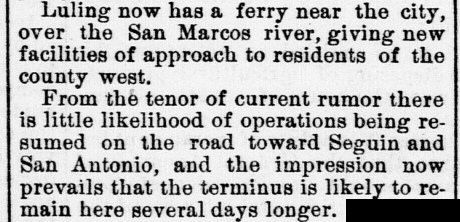 |
Despite an offer of
$100,000 from Comal County (a huge sum in those
days) if he would build the GH&SA into New
Braunfels, Peirce kept the railroad on his planned route, reaching
San Antonio in 1877. Approached by the Southern Pacific (SP) Railroad, Peirce began discussing an extension of
his line westward to El
Paso to connect with SP rails being laid east from California. Financed
entirely by SP, Peirce's El Paso
extension was
completed in 1883 and the GH&SA was then leased and ultimately acquired by SP.
SP's
southern transcontinental route passing through San Antonio spurred additional
commerce and helped to enhance San Antonio's reputation as a major
inland commercial center. This inspired other investors to lay rails into San
Antonio, among them Uriah Lott.
Lott was more a dreamer than an investor, but he
chartered the San Antonio & Aransas Pass
(S&AP) Railway in 1884 with plans to
connect San Antonio with
Aransas Pass, a port on the Gulf of Mexico. By late
1886, SA&AP tracks had been laid between San Antonio and
Corpus Christi, the latter chosen as the Gulf
endpoint instead of Aransas Pass. With its main line completed, the SA&AP began expanding in south Texas.
In 1889, it built a 54-mile
branch line from Shiner to Lockhart, crossing the GH&SA tracks at Luling, a
location interlocked with a 26-function mechanical plant on June 20, 1904 when Tower
40 was commissioned by the Railroad Commission of Texas (RCT).
SP had acquired the SA&AP in 1892 but
was forced to divest it in 1904 due to a successful lawsuit filed by the State
of Texas (but the divestiture did not motivate the interlocker, which had been
planned since 1902.) SP wanted to find a way to regain control of the SA&AP, and
they were helped by the Transportation Act of 1920. It directed the Interstate
Commerce Commission (ICC) to promote and plan for the consolidation of U.S.
railroads into a limited number of "systems". The plan adopted by the ICC
proposed that SP head one of these systems, with the SA&AP becoming part of it.
On December 6, 1924, SP filed an application with the ICC for authorization to
obtain control of the SA≈ the State of Texas opposed the move. The ICC
ruled in favor of SP and in March, 1925, the SA&AP
was re-acquired by SP and leased to the GH&SA. Controlling both of the Tower 40
rail lines, SP chose to retire the interlocker in 1931, and in 1933, the SA&AP line from
Luling south to Shiner was abandoned. Fortunately, Tower 40 was not razed and it
has remained standing near its original location.
Tower 40 (Jim King
photo, August 6, 2005)
Tower 40 (Google Street View, 2011)
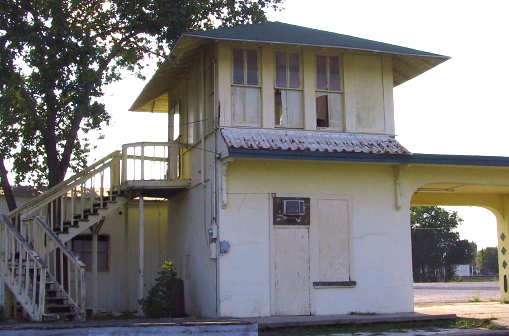
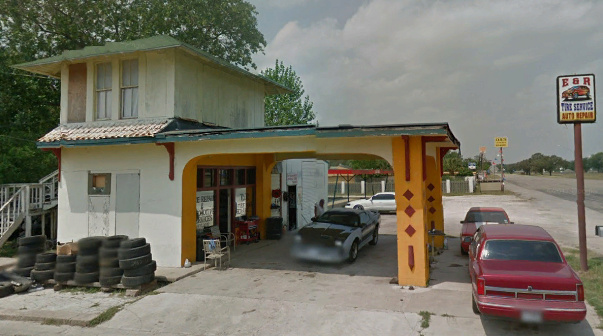
Above: Within a few years
after abandonment, Tower 40 was relocated a short distance south of the SP
tracks and became a gas station at the corner of Mesquite St. and Pierce St. In 2011, it was the home of E&R Tire Service. It remains one of the
few Texas interlocking towers still standing today.
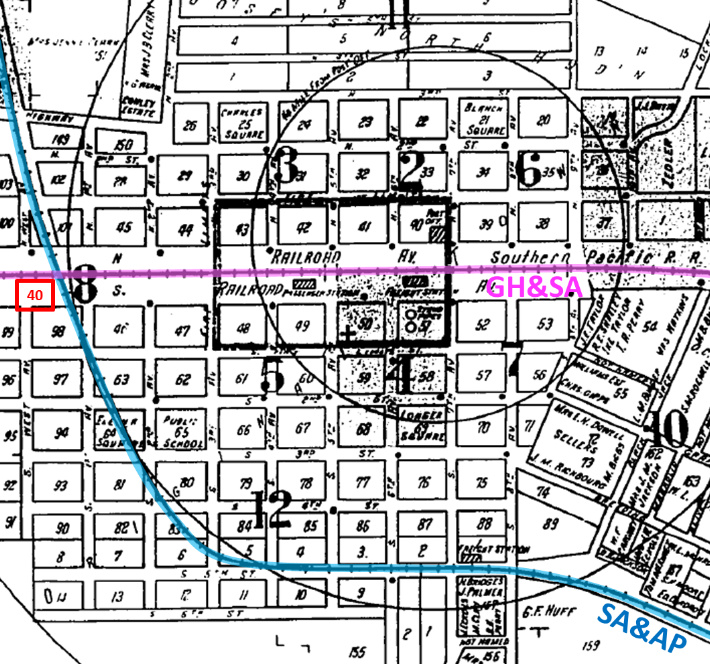
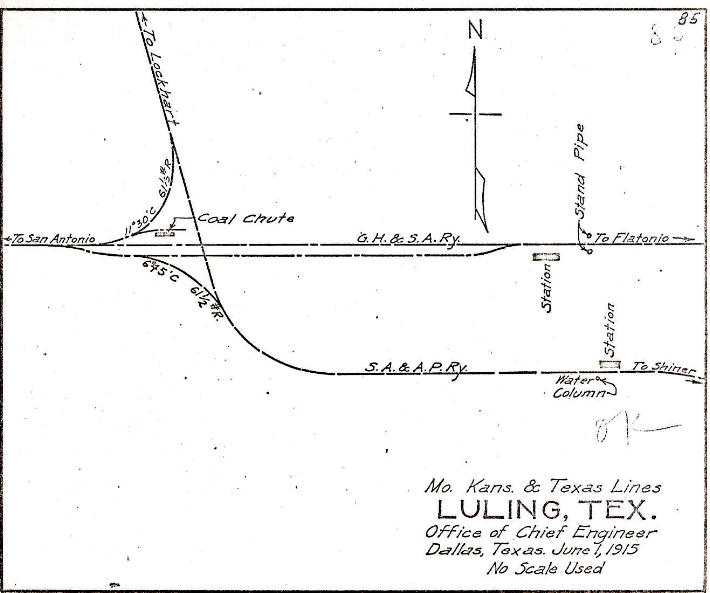
Above Left: This 1929
Sanborn Fire Insurance index map has been annotated to highlight the Tower 40 rail crossing on the west side of Luling.
Above Right: The crossing of
the two railroads in Luling is apparent on this 1915 track chart from the Chief Engineer's office
of the Missouri, Kansas & Texas
(MK&T) Railroad. That office maintained a reference library of track charts for most major
railroad junctions in Texas, even those, such as Luling, which did not involve
the MK&T. (courtesy Ed Chambers)
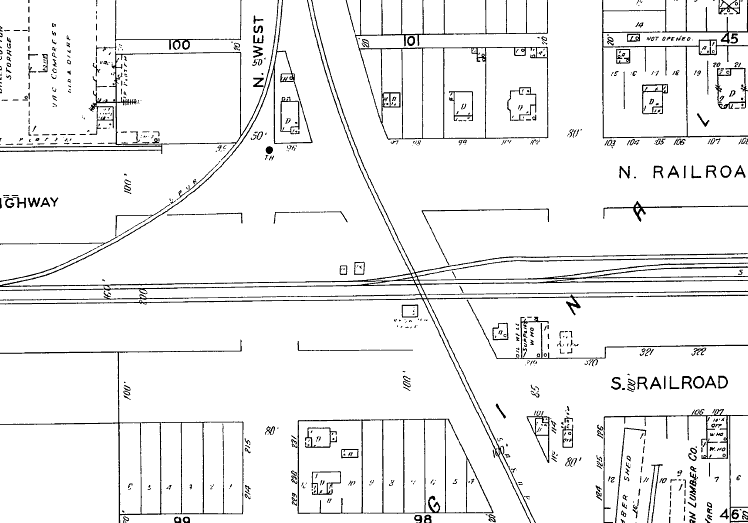
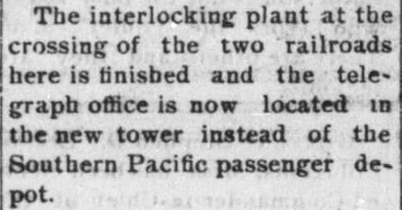
Above Left: This image from the 1929 Sanborn map shows Tower 40 located in the southwest
quadrant of the crossing. The lettering beneath the tower is not legible, but
it appears to have
been "Railroad Tower". Above Right:
The Lockhart Daily Post of June 17, 1904, in
its "Luling" column of news reports, carried this one-sentence item announcing that the
Luling telegraph office had been relocated to the new interlocking tower. The
tower was commissioned by RCT three days later.
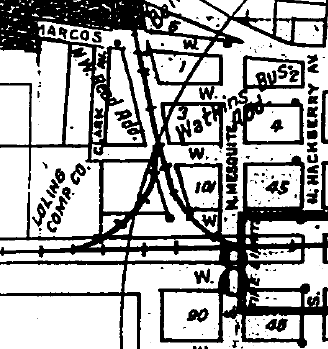 |
Left:
The 1941 Sanborn index map shows that Mesquite was the name of the
north/south street adjacent to and slightly east of the crossing. Note
also that by 1941, the route of the ex-SA&AP south of the crossing was
abandoned (1933), but the northerly segment to Lockhart was still
intact. It was abandoned by SP in 1942.
Right: The Tower 40 structure was relocated a few
dozen yards south of the crossing and became part of a gas station. The 1941
Sanborn map shows a "Filling Sta" located on the corner of Mesquite St. and
Pierce St., where Tower 40 continues to reside. The "2" indicates that the
station structure had two stories and the almost illegible "1" in the
box above it is the overhang built to shelter the pumps. "S. Railroad" became "Pierce"
sometime between 1929 and 1941. This is presumably another manifestation
of the confusion regarding Thomas W. Peirce's last name,
spelled "ei", not "ie". |
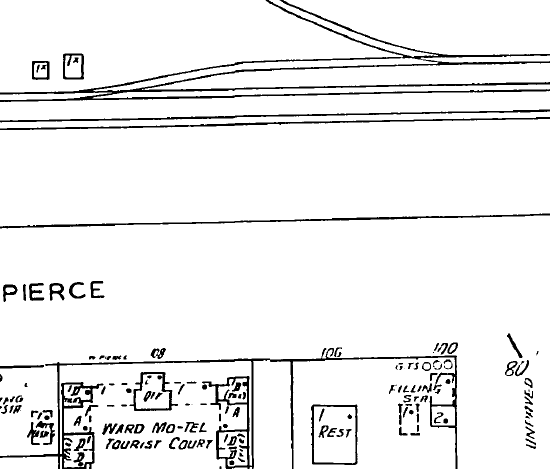 |











